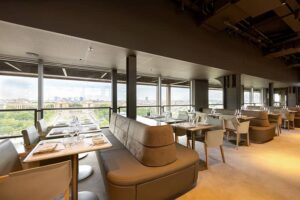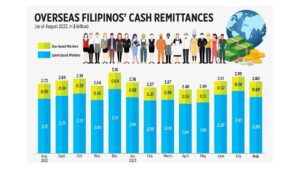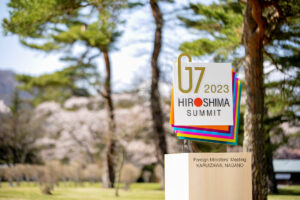We will always have Paris

By Joseph L. Garcia Reporter
Restaurant ReviewMadame BrasserieEiffel Tower, Paris
ACCORDING to legend, French author Guy de Maupassant, like many intellectuals in France near the turn of the century, hated the Eiffel Tower when it first opened in 1889 for the World’s Fair of that year. That didn’t stop him from eating lunch there almost every day — for it was only there where he couldn’t see the tower itself.
During a trip to Paris this reporter took in March, we had the pleasure of dining at the restaurant at the Eiffel Tower’s first level, Madame Brasserie. There is another restaurant on the second floor, the Jules Verne, with one Michelin star (and therefore, more expensive than the one below it).
Think about it: in dining in this restaurant, one gets a taste of French cuisine surrounded by a view of all of Paris. There’s very little gimmick here: it’s just great set design. From the windows, one can see the Seine and the Palais de Chaillot straight ahead, and a panoramic view of the 16tharrondissement.
Thankfully, we made our reservations months beforehand, as the lines to enter the tower were long. Even if our printed reservations managed to slip us through an entrance with a shorter line, we still had to share the lift with everybody else (liberté, égalité, fraternité, and all that). The crowd, as expected, looked touristy (ourselves included; as well as the woman with an upstate New York accent we talked to while we waited in line), save for three or four very well-dressed people who we discerned from their conversation, were there for an anniversary of sorts. The whole journey to the top was a treat, still: the line to the lift and the lift ride just gave one more time to observe the bones of the structure itself, while a glass tile at the viewing deck offered a view of the crowds teeming below.
We arrived for a casual lunch, priced at about 48 euros each, with a starter, a main course, and dessert; as well as two glasses of wine. The hostess could be friendlier, but our server that day (whose name escapes us) was a perfect picture of French hospitality: he had a perfect sense of timing (never too early or too late), always knew what to say, and helped finish our infantile French sentences to aid us in appearing more worldly and mature. The restaurant is helmed by Thierry Marx, a pioneer of molecular gastronomy, with several Michelin-starred restaurants across France (earning his first in 1988), and named Chevalier de la Légion d’Honneur in 2013.
Now, for the food: the family, cold on a windy spring day, unanimously decided on the Velouté de courge butternut, magret de canard fumé et châtaignes (the menu at the door thankfully came with a translation: Butternut squash velouté, smoked duck breast and chestnuts). Since there were three of us, we decided to try each other’s dishes: this reporter went with the Aile de raie à la Grenobloise, chou-fleur et noisettes torréfiées (Skate wing à la Grenobloise, cauliflower and toasted hazelnuts); le Beau-père (to my stepfather’s delight, the word for stepfather in French translated to “handsome father” in English) picked the Filet de volaille jaune fermière, mousseline de céleri trufée, et jus à l’orange (Farm chicken breast, celery mousseline with truffle, orange jus), and Maman (it sounds almost the same in almost any language) chose the Poitrine de cochon fondante de Monts du Cantal, lentiles Beluga, carottes et céleri (Tender pork belly from Monts du Cantal with Beluga lentils, carrots and celery).
The soup was a bit cold, and could have taken the experience to another level with the right temperature. Still, it was blessed with a great texture and an excellent and robust smoky flavor imparted by the duck. The skate — well, it turns out fish in browned butter tastes the same wherever you eat it, though the fish bones were so soft one could chew them — but we were very pleased with the freshness of the vegetables. Every bite had a snap and a little bit of fight in it (in a good way), as if the plant were still very much alive. The pork was very flavorful, with an unmistakable sweetish flavor that suggested a good life for the pig. The chicken was very tender and had a clean, almost creamy taste — and that’s just the flesh alone.
As for dessert, two of us chose the Mousse au chocolat noir intense, biscuit moellux au chocolat et streusel au cacao (Dark chocolate mousse, fondant sponge and cocoa streusel), while Maman chose the Riz de Camargue fondant végétal a la vanilles, poires confites et châtaignes (Creamy vegetal rice from Camargue with vanilla, pears confits and chestnuts). The chocolate mousse had little restraint and was almost as pure an expression of chocolate as can be; strangely enough, despite the intoxicating weight of its taste, it landed light as a feather in the stomach.
On paper, the dishes sound very uncomplicated. The magic (aside from the view, bien sûr) can be found in the local sourcing of the ingredients, their origins so proudly displayed on the menu. “As an artisan, my mission is to make the ephemeral memorable. My challenge is to create simple, healthy, pleasurable cuisine, as sustainable as the monument itself,” said Mr. Marx on the official website of the Eiffel Tower. It’s easy to turn one’s nose up at experiences made exactly for tourists, but why should one shy away from such a grand welcome? The bright and clear flavors of the dishes, paired with a view that showed off the best of Paris are salutes to the greatness of French soil and the people who live on it.




